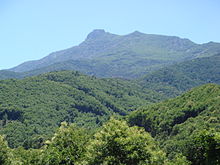Castagniccia
Castagniccia is the name of a hilly landscape on the French island of Corsica in the Haute-Corse department . It is located between Golo in the north and Tavignano to the south in the eastern half of the island, at the same time Castagniccia is the Corsican name for "chestnut selve ".
The characteristic sweet chestnut ( Castanea sativa ), which is also known as the sweet chestnut , covers an area of around 15,000 hectares in the Castagniccia area alone. The planting of sweet chestnut groves near the settlement was largely promoted by the Genoese in order to alleviate the famine that occurred again and again at the time alleviate. For this purpose, numerous fresh stone and downy oak sites were cleared and converted into the Mediterranean chestnut landscape that is still characteristic today. In addition to cattle breeding (sheep, goats), the chestnuts were the main source of food for the Corsicans - hence the name “bread tree”. The fruits were dried and made into flour or served as fodder and helped the region to a certain degree of prosperity. Visible signs of this are large churches that can still be found today in the center of every village, no matter how small.
In the 18th century the Castagniccia was a center of the Corsican independence movement. The numerous monasteries were the meeting place for freedom fighters and the center of resistance. Pasquale Paoli was born in Morosaglia , in the north of Castagniccia.
Cervione is known as the seat of the bishops of Aléria in the late Middle Ages , as well as the residence of Theodor von Neuhoff , who was elected King of Corsica on April 15, 1736 by a convention of the Corsican population in the monastery of Alesani .
In Orezza there is now, in addition to the ruins of a monastery, a spring that is valued far beyond the borders of Corsica and which was probably known in ancient times. A health-promoting effect of this water has long been recognized, this is also underlined by an imperial decree of February 7, 1866.
In the 19th century, the Castagniccia had the highest population density of any region on the island. Today Castagniccia, which was still prosperous 100 years ago, is just as affected by the rural exodus as many other rural areas of Corsica. This was accompanied by the decline of the chestnut groves, which were now used as pasture for semi-wild domestic pigs, were no longer cared for and were weakened by diseases. In the meantime, however, the importance of these trees that shape the landscape has been rediscovered, and in some places the long-neglected tree cultures are being restored. Since the 1990s, more and more local products made from the flour of Corsican chestnuts have been on sale again, such as the increasingly popular Pietra chestnut beer .
Attractions
Places of interest in Castagniccia are Cervione, Pedicroce, la Porta and the monastery in Alesani. The small mountain village of Campodonico is the starting point for a hike on Monte San Petrone , at 1767 m the highest point in Castagniccia.
literature
- Hannes Mayer : The forests of Corsica. Walks through a forest paradise. 2nd revised edition. Fischer, Stuttgart et al. 1990, ISBN 3-437-30624-3 .
- Klaus Wolfsperger: Hikes in Corsica. 9th edition. Rother, Ottobrunn, ISBN 978-3-7633-4280-8 .

